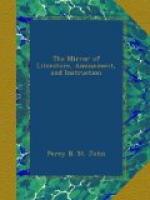contracted to purchase as much of it as could be supplied,
and continued to gain by Cornish ignorance for a considerable
time. The first discoverer of the ore was called
Poder (it long went by his name), who actually abandoned
the mine in consequence; and we find that it was for
some time considered that “the ore came in
and spoilt the tin.” In the year 1822
the produce of the Cornish copper mines amounted to
106,723 tons of ore, which produced 9,331 tons of
copper, and 676,285 l. in money. In the same
year, the quantity of tin ore raised was only 20,000
tons. The Irish and Welsh ores are generally
much richer than those of Cornwall; but occasionally
they strike on a very rich lode (or vein) in
that county. Last spring, some ore from the Penstruthal
mine was ticketed at Truro, at the enormous price
of 54 l. 14s. per ton; and a short time previous,
in the Great St. George Mine, near St. Agnes, a lode
was struck five feet thick, which was worth 20 l.
a ton. There are only six other copper-works
in the kingdom besides those of Swansea, five of which
are within fifteen miles of that town; the other is
at Amlwch (in the isle of Anglesea), where the Marquess
of Anglesea smelts the ore raised in his mines there.
The annual import of ore into Swansea in 1812 was
53,353 tons; in 1819, 70,256 tons were brought coastwise:
besides which, several thousand tons of copper ore
are imported from America every year. Since this
period there has been a large increase. Most
of the ships which are freighted with copper ore load
back with coal, for the Cornish and Irish markets.
Of bituminous, in 1812, 43,529 chalders, and in 1819,
46,457 chalders were shipped coastwise, besides a
foreign trade of about 5,000 chalders every year.
Most of this goes to France, the French vessels coming
here in ballast for this purpose; but all coal shipped
for abroad must be riddled through a screen composed
of iron bars, placed three-eighths of an inch apart,
as it is literally almost dust. Great hopes are
now entertained here that government will abolish
the oppressive duty on sea-borne coal. In the
stone-coal and culm[3] trade, Swansea and Neath almost
supply the whole kingdom. Independent of foreign
trade, 55,066 chalders of culm and 10,319 tons of
stone-coal were shipped coastwise in 1819: last
year the ports of Swansea and Neath shipped 123,000
chalders of stone-coal and culm. Stone-coal improves
in quality as it advances westward. That of Milford,
of which however only about 6,000 chalders are annually
exported, sells generally at from 50s. to 60s. per
chaldron in the London market—a price vastly
exceeding the finest Newcastle coal. It emits
no smoke, and is used principally in lime-burning
and in manufactories where an intense heat and the
absence of smoke is required. The Swansea culm
is mostly obtained about thirteen miles from the town.
The bituminous coal mines in the vale of Tawy are
fast getting exhausted, and the supply of coal must
at no distant day be drawn farther westward, near the




